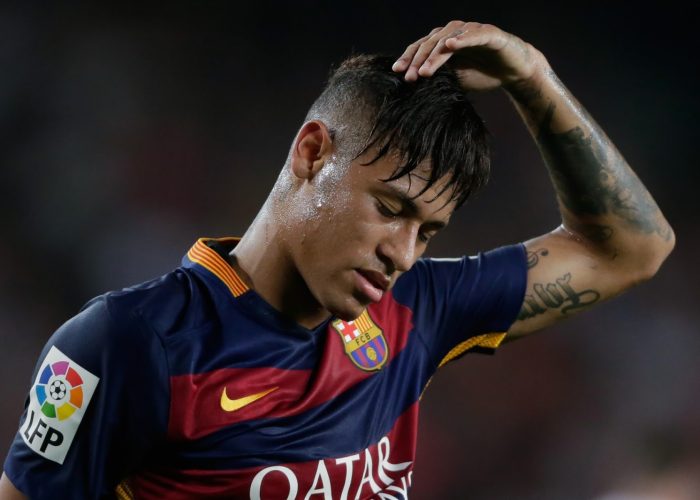



The saga of the summer has finally ended with Neymar finishing his tenure at Barcelona and instead switching to Paris Saint-Germain following his 222 million euro release clause being paid.
THERE’S a veritable kaleidoscope of vantage points from which to consider the transfer of Neymar da Silva Santos Junior, AKA you-know-who.
We’re not just talking the most expensive footballer of all time; we’re talking a guy who cost more than a quarter of a billion dollars. That’s Paul Pogba plus Cristiano Ronaldo with enough left over to cover their wages until Christmas.
This is not, as some have suggested, the end of football as we know it. It’s either a bold, game-changing move from Paris Saint-Germain or a colossal blunder by folks with more money than sense or, perhaps, something in between. Yet the web of implications is so far-reaching that it’s worth looking at this deal from various perspectives.
Barcelona
This is probably more of a psychological setback than a footballing one. It’s the third time a buyout clause has been used by a rival club to swoop into the Camp Nou and make off with a prize asset. Twenty years ago, Inter showed up with $27 million — don’t laugh, young readers, it was a world record at the time — and secured the original Ronaldo, the “Phenomenon”. In 2000, Real Madrid made off with Luis Figo for $74m, launching the Bernabeu’s “Galactico” era.
Ronaldo was the reigning World Player of the Year and had yet to turn 21; you’d be hard-pressed to find a player not named Pele who had achieved so much, so young. Figo, meanwhile, was 28 and one of the best wingers in the world, but Madrid weren’t buying potential with him; they were simply rubbing the opposition’s noses in it.
On the pitch, Barcelona can likely reload pretty quickly without Neymar. Not in terms of finding the heir to Lionel Messi, but in coming back as one of the best teams in the world. It’s going to be expensive — $262m is a lot to have burning a hole in your pocket and potential sellers will want a big chunk — but, if done right, it can be pretty painless.
And, perhaps, simply having Messi and Suarez, instead of the much-vaunted MSN up front, will give new coach Ernesto Valverde more tactical freedom. The bottom line is that Barcelona won before Neymar’s arrival, they won with Neymar and they’ll likely win again without him.
Where it does hurt, is inside. The Barcelona that lost Ronaldo and Figo was not today’s Barcelona. Those sides weren’t among the top three or four in the world and the footballing landscape wasn’t as polarized as it is today. The message here is that a superstar wanted to be elsewhere. And that’s tough to swallow.
Equally tough to accept is how this came about. It’s not as simple as saying Barca ought to have set a higher release clause; it’s about misreading Neymar and Co. when he signed his new deal less than a year ago. Particularly when Barcelona knew full well how his camp — read: his father — operates.
Paris Saint-Germain
This is like getting the top draft pick in the NBA lottery and choosing the best player available, rather than drafting for need. PSG’s squad is already teeming with attacking midfielder/winger types, like Julian Draxler, Angel Di Maria, Lucas Moura, Hatem Ben Arfa, Javier Pastore and Goncalo Guedes.
Sure, Neymar is better than all of them and you can never have too many great players but, in terms of resource allocation, figuring it all out won’t be easy. If they move some on, as you suspect they will, they’ll do so as “motivated sellers,” which knocks down the price. There’s a lot there for sporting director Antero Henrique and manager Unai Emery to sift through and not much time in which to do it.
Some draw a parallel with the 2012 signing of Zlatan Ibrahimovic, who helped deliver four straight league titles and quarterfinal finishes in the Champions League. He put PSG on the euro-superpower map,but you’d imagine Neymar would need to do better for his signing to be defined as a success.
That’s a tall order and it likely will depend as much on those around him as it does on Neymar himself. At 25 years of age, how much better can he realistically get?
Neymar
Let’s start with an anecdote. While in Brazil for the 2013 Confederations Cup, I flipped on the TV. It went to a commercial break and five of the seven ads featured Neymar. He was 21 at the time, already the undisputed leader of the Selecao and he was ubiquitous. It’s pretty obvious that whatever runs through his veins is positively reptilian; few superstars in any sport handle pressure and scrutiny with his level of aplomb.
Maybe that’s why there is some stock in the theory that this move isn’t just — or, only — about Euro signs. Maybe he really wants to be the superstar on a successful team he can call his own (something that won’t happen at Barca as long as Messi is around).
Is it gullible to give him the benefit of the doubt? I’m not so sure. He’ll certainly earn more at PSG but it likely won’t be “move-the-needle” type more. Not compared with the opportunities that come with being a Brazil and Barcelona legend.
And there’s a flip-side: This move is not without risk. PSG, in terms of exposure and prestige, aren’t in the same hemisphere as Barcelona, particularly if they underachieve. A couple more seasons like last year with no Champions League football in April could see his mantle of heir apparent to the Messi-Ronaldo crown slip, even if he performs well with Brazil.
Whatever you think of Neymar, this does not seem like something motivated chiefly by greed or manipulation; this is a superstar wanting to really challenge himself, rather than continue in a supporting role.
In other words, I want to believe these words are genuine.
Financial Fair Play
Forget the hysterical reaction from La Liga and Catalonia and forget discussion of covert payments to be the “face” of Qatar 2022 and other such nonsense. FFP hasn’t been “relaxed,” it’s still around and it’s very real (just ask Roma or Inter or Galatasaray). And, if PSG can’t afford Neymar without breaching the requirements, we’ll find out.
It’s just that we won’t know until the fall of 2018, when seasons 2015-16, 2016-17 and 2017-18 are cumulatively assessed, whether PSG violated FFP rules, which dictate that no more than $35.6m can be lost over three seasons, though some expenses and revenues aren’t included in the FFP calculation.
And that last part is crucial. PSG’s official accounts show a profit of $12m for 2015-16 but that’s largely irrelevant because more than a quarter of their revenues came courtesy of a sponsorship deal with the Qatar Tourism Authority, worth some $240m. UEFA found the amount to be grossly inflated and discounted it by around 50 percent.
They have the power to do the same if things don’t add up. And, by the way, spending $262m on Neymar doesn’t mean a $262m hit in their accounts. Transfer fees get amortized over the life of a contract, which means it will cost them a fifth in his first year.
Throw in his wages and you’re looking at north of $100m which, while still a frightening number — Messi is costing Barcelona half of that — is possibly more manageable if you’re smart with your sales and you squeeze out commercial revenue properly.
UEFA
Europe’s governing body has a wide scope of interpretation when it comes to “related-party transactions” — basically, anything that can be traced back to Qatar, since Neymar’s new employers are effectively owned by the country — and there’s no clever sleight-of-hand to get around it.
If UEFA suspect a sponsorship is inflated they get experts involved, who compare it against industry benchmarks and comparable clubs and assess a fair market value. That’s what they did in 2013 when PSG and Manchester City were sanctioned along similar lines.
Back then clubs were offered a “settlement agreement” — basically a plea bargain — where they agreed to certain fines and restrictions as punishment. If other clubs don’t believe the “settlement agreement” is stiff enough, they can appeal it and send the case to the Club Financial Control Body’s Adjudicatory Branch, who have sweeping powers and are entirely independent.
That’s key here. In 2013, not least because it was the first year of FFP, some felt that PSG and City got off lightly but there were no complaints to UEFA. It’s hard to see that scenario occurring again, not with Barcelona and other big clubs likely to exert pressure on UEFA. And particularly not now that they happen to be, officially, business partners in the Champions’ League and Europa League.
Transfer fees
Some fret over the “football bubble” bursting, but we’re not talking dotcoms or even tulips. When FFP was introduced in 2010, European clubs were losing, on aggregate, nearly two billion dollars a year. Now, those losses are down to just over $300m.
You don’t need to be an economist to know that it’s OK to spend more if you’re earning more money; Barcelona’s revenues, for example, have gone up nearly 70 percent in the last seven years. The vast majority of Europe’s richest clubs — the ones who spend big on transfer fees — have seen comparable rises. What’s more, most of them are profitable.
It’s not as if, because Neymar costs $262m, Ingolstadt or Atalanta or Celta will suddenly need to spend $20m to sign a decent right-back. What happens at the top of the market does not trickle down to the middle classes any more than a hedge fund manager blowing $1.5m on a Lamborghini Diablo means the man in the street not being able to buy a family sedan for $30,000.
What’s more, markets have a way of correcting themselves, particularly now that we have oversight. Contracts expire and players — read: assets — can be sold. This is neither the end nor the beginning of the end.
Instead, it’s a massive deal caused by very specific and unusual circumstances. Football will be just fine. – kwese.espn.com